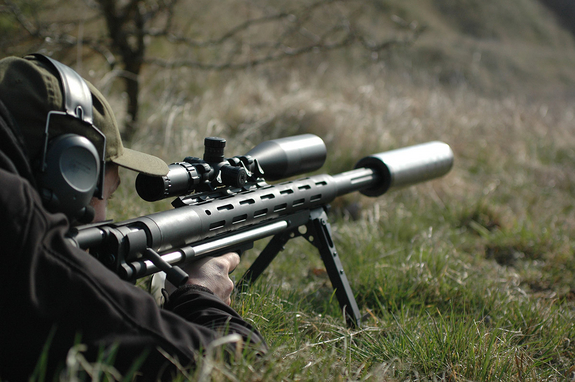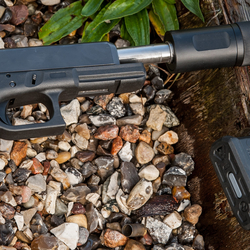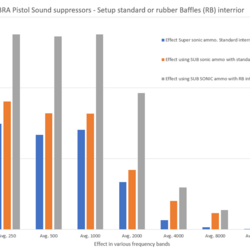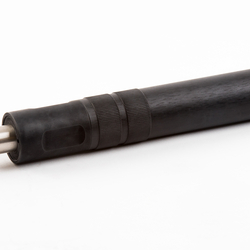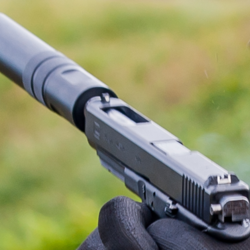The SAI COBRA pistol silencer system is made for the pistol shooter, who wants the widest possibilities to perfectly set up a silencer for his personal needs.
The same silencers can be set up for different calibers and for different tactical situations, from shooting practice on the shooting lane to super silent operations.
The SAI COBRA silencer system is made for use on pistols, caliber 6,35 - .45 caliber.
The series includes 3 different models:
- COBRA Impuls+
- CCOBRA Direct
- COBRA RB
The COBRA Impuls+
A silencer designed with an integrated impuls device also known as a Nielsen Device. This impuls device enables pistol shooters to use silencers on typical pistol actions where the barrel activates the recoil motion. No tools are needed for fitting or removing the silencer. The spring power of the impuls device can be adjusted with a ball point pen to regulate the spring pressure according to caliber and ammunition type used. Will operate even on full auto Glocks.
The COBRA Direct
For pistols with a non-moving barrel. Same baffle set up as Impuls+ model, “K” and “H” types but shorter and direct fit to barrel.
The COBRA RB
COBRA RB model is a special silencer / suppressor that uses disposable rubber baffles – it is VERY quiet, even with supersonic ammunition, but the baffles is burnt away in between 50 – 80 shots depending on ammunition used. The COBRA RB model works on all pistol models even without impuls unit fitted.
| Specifications | |||
|---|---|---|---|
| Model | COBRA Impuls+ | COBRA Direct | COBRA RB |
| Caliber: | 7,65 - .45 | 7,65 - .45 | 7,65 - .45 |
| Length: | 200mm | 158mm | 158mm |
| Diameter: | 32mm | 32mm | 32mm |
| Weight: | 255gram | 197gram | 175gram |
| Materials: | Alu/Steel | Alu/Steel | Alu/Steel |
| Surface: | Black non glare | Black non glare | Black non glare |
The SAI COBRA line of silencers are very user friendly and can be used and serviced without the need of tools.
Choice of baffle types
For different tactical situations, different baffle types can be inserted by the operator on all COBRA models.
The range of possible use varies from everyday use, over special needs to stealth situations, requiring maximum silenced shoots.
All COBRA models can be taken apart for cleaning and maintenance.
What is Sound?
- The sound from a firearm is in fact a combination of the following five sounds:
- The powder gases leaving the barrel
- The supersonic boom of the bullet
- The mechanical sound from the firing action
- The bullet flying through the air
- The bullet impacting the target (Ambient effects, such as echo also affect the perception of sound)
Sound propagates like a wave motion. Sound waves can be described by their frequency, which is an expression of the number of waves per unit of time. The standard unit is 1 / second, which is also called Hertz [Hz]. A normal human ear can perceive sounds in the frequency range from 20Hz to approx. 20,000Hz.
Sound waves are also described by their strength, referred to as amplitude. The amplitude indicated the volumes, most often measured in bell or deci Bel [dB]. Basically, the dB differs from other standard units in that it is logarithmic. A Bel thus expresses the ratio of a physical quantity relative to a specified or implied reference level. In relation to sound pressure (Sound Pressure Level), the ability of the human ear to perceive pressure changes is taken into account. The human ear can detect pressure changes of at least 20 µPa.
The term dB is used without weighting as an indication of a given sound pressure, expressed by SPL (Sound Pressure Level).
Distribution of sound in free field
The sound propagates spherically in outdoor free surroundings, with reflection of the sound when the sound waves meet a geometry - Be it the surface, forest, trees, houses, etc. The surface nature of the geometry determines how and how much the sound is reflected.
Spherical propagation of sound
Mathematically speaking, a sound source in a free environment is considered as a sound from a point. This point expands spherically and is similar in all directions, assuming that there are no reflective objects and “nature” obstructing the spherical distribution. The intensity of the sound decreases as the distance to the sound source increases. This means that the area occupied by the energy of sound grows with increasing distance to the sound source.
In free field surroundings the sound is thus reduced by 6 dB for each doubling of the distance to the sound source.
Different sounds have different frequencies – Typically many interfering frequencies, that all have different impacts on the human ear – Some frequencies are intercepted as being louder than other frequencies, even though the loudness of the sound itself – Measured in deci Bells is not that loud. This makes sound measurements rather complicated. Long-term exposure to noise and age also affects the ability to detect sounds, and to varying degrees we are also affected differently by different sound frequencies. Ambient weather conditions and the type of terrain the shooter finds themself in also affect the perceived sound, sometimes quite radically.
The strength of the sound is perceived differently at different frequencies.
One factor in assessing a sound is the subjective strength of the sound; How loud a given sound is perceived. The fact that something is "subjective" can put any arithmetic nerd or mathematical theorist down. This is because the values used must be retrieved from tables based on experience and question rounds instead of a mathematical formula. Again, sound pressure is not perceived equally in the different frequency ranges. Low frequency sounds are perceived lower than sounds in the medium frequency range. The human ear is most sound sensitive at approx. 3000Hz. This frequency area is the most important area, when it comes to sound reduction of a firearm of any kind.
To make a long story short: Within psychoacoustics, the thesis is, that perceived sound volume, which is measured in so-called "son", doubles resp. reduces by 50% when the sound pressure increases or decreases by 10dB.
What sound can sound suppressors reduce?
If we analyze the five sounds listed above, the loudest sound produced by the firing of a firearm is that of the powder gases escaping the barrel – which is precisely what a sound suppressor is able to reduce.
As well as suppressing sound, a sound suppressor also significantly reduces recoil and muzzle blast, which has a positive effect on the shooter's aiming accuracy.
Are there any disadvantages to using a sound suppressor?
There are many benefits to using a sound suppressor, though it’s also important to understand what other factors come into play when using a sound suppressor, namely impact shift, the need to recalibrate the sight, the added weight and length of the firearm, and the additional wear on full and semi automatic firearms due to increased pressure during repetition firing.
Sound measurements:
Software used for measurements in this documentation is developed using the criteria listed in the NATO Protocol (NATO standard AEP-4785. Edition A, version 1, from August 2016)
In developing the rubber baffle system for our pistol line of sound suppressors, SAI made a series of detailed sound measurements on 9mm pistol caliber with sound reduction. The tests were made with sub sonic as well as with super sonic ammunition.
Ammunition from the same batch has been used and the measurements have been carried out under the same weather conditions – On the same day using the same set up and measuring gear.
The interesting part is the effect of the sound suppressor, defined as the measured SPL without a sound suppressor, minus the measured SPL values with a sound suppressor. The difference is the effect of the sound suppressor.
- What the shooter hears the most is the range form 500 – 5000Hz.
- The ear’s perception of a 50% reduction of the sound corresponds to a reduction of 10 dB SPL
What you should consider
Modern sound measuring technology has far exceeded the human ear’s ability to determine the relative performance of the many different sound suppressors on the market today. Once you have defined your requirement, we therefore recommend trying out our products for yourself.
We are always on hand to assist with any questions you have relating to our product range.
